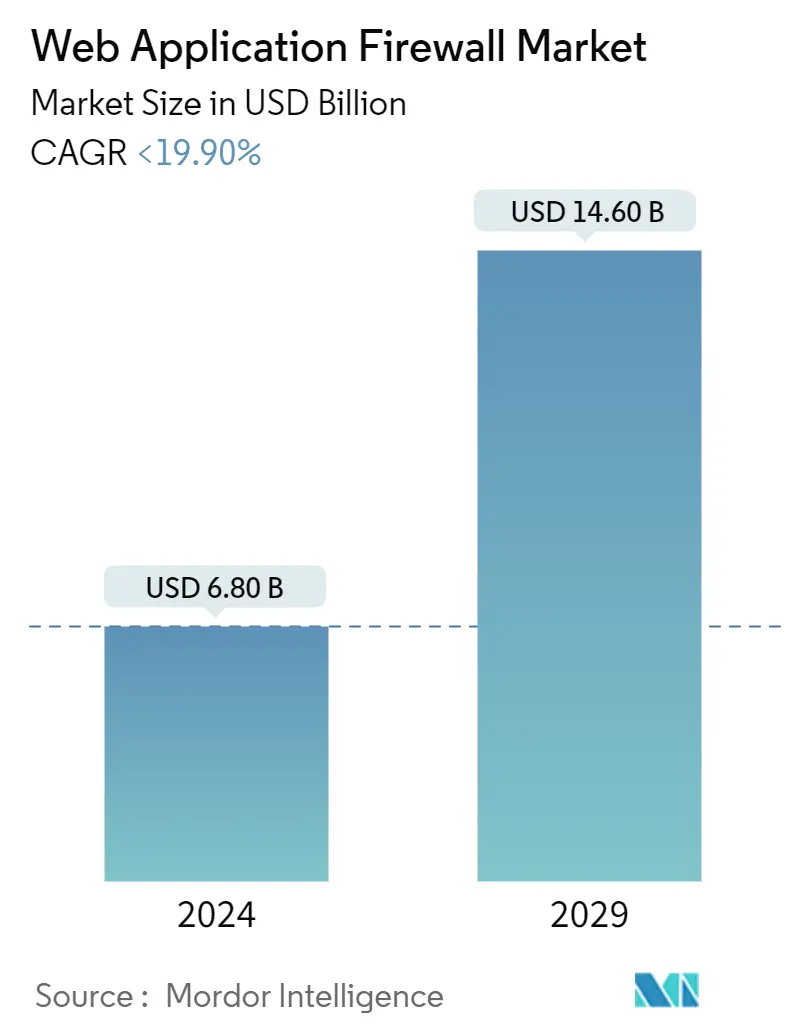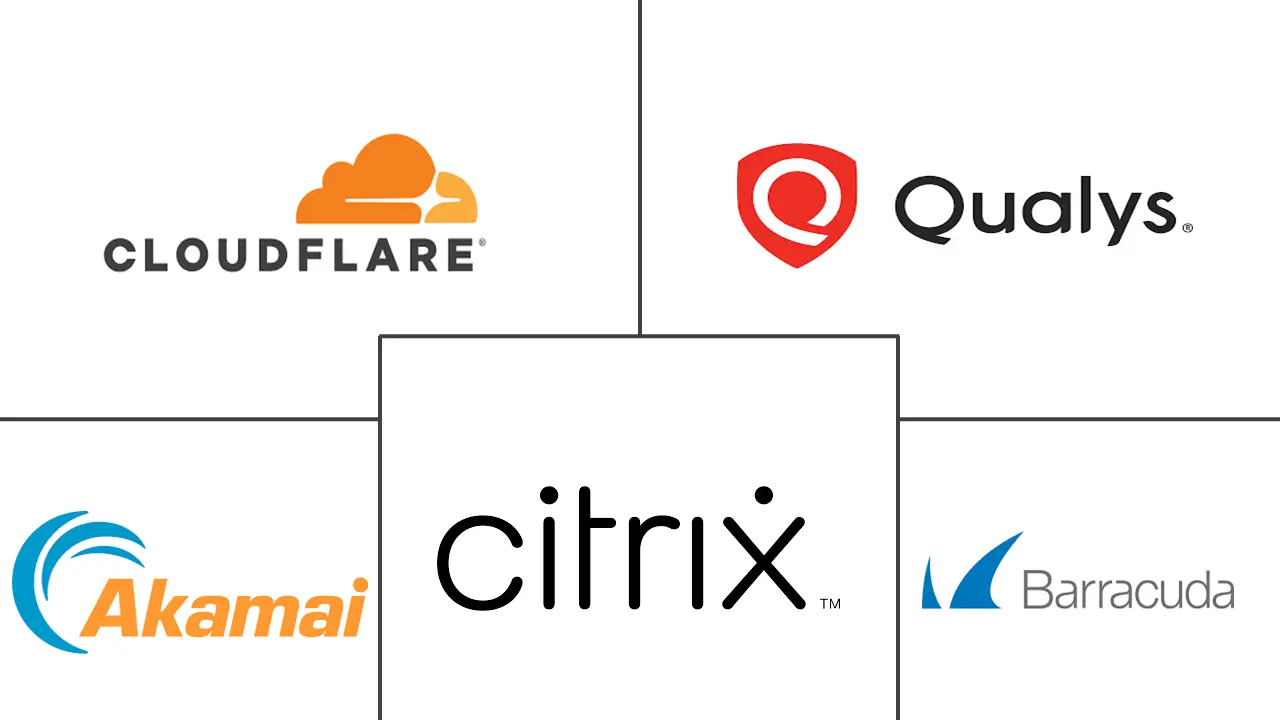Market Size of Web Application Firewall Industry

| Study Period | 2019 - 2029 |
| Market Size (2024) | USD 6.80 Billion |
| Market Size (2029) | USD 14.60 Billion |
| CAGR (2024 - 2029) | < 19.90 % |
| Fastest Growing Market | Asia Pacific |
| Largest Market | North America |
| Market Concentration | Low |
Major Players
*Disclaimer: Major Players sorted in no particular order |
Web Application Firewall (WAF) Market Analysis
The Web Application Firewall Market size is estimated at USD 6.80 billion in 2024, and is expected to reach USD 14.60 billion by 2029, growing at a CAGR of less than 19.90% during the forecast period (2024-2029).
Rising cyber theft and fraud incidents and rigorous government policies governing data and cyber security will likely drive market growth. Furthermore, web-based apps and services have changed the nature of information distribution and exchange in today's business, government, and educational sectors. The firewall market is becoming increasingly crucial for the deeper integration of internal information systems because of the low cost of information and the wide range of online and web-based services.
- Whether expressly or indirectly, specific enterprise and government laws necessitate the adoption of a WAF (Web Application Firewall) solution. For example,(PCI-DSS) is a renowned and significant standard that supports the use of WAF. WAF functionality may be implemented in software or hardware and operate on an appliance device or a conventional server running the same operating system.
- Furthermore, organizations with online commerce and banking platforms primarily use WAFs to safeguard their operations and protect sensitive consumer data. Again, the rising use of firewalls in healthcare is driving the market. WAFs prevent unauthorized access to critical healthcare networks and electronic patient information using Wi-Fi-enabled equipment and other related devices.
- On the other hand, web application firewalls confront two significant challenges: cost and performance. Performance is typically challenging with these tools since they monitor all incoming and outgoing information at the application layer. Each protocol, such as HTTP and SMTP, has its proxy program, and it might take a long time for new network applications and protocols to receive support.
- Due to unusual conditions, the COVID-19 outbreak increased demand for web application firewall solutions during the last two years. Many firms, for example, centered their security efforts on endpoint protection for work-from-home systems. Furthermore, enterprise security teams needed more resources to address multiple online application security concerns, increasing the demand for a reliable web application firewall.
Web Application Firewall (WAF) Industry Segmentation
The web application firewall is an application firewall for HTTP applications. Web applications are valuable tools for businesses of all sizes. A WAF can be either network-based, host-based, or cloud-based and is often deployed through a reverse proxy and placed in front of one or more websites or applications. These applications enable businesses to communicate with customers, potential customers, employees, partners, and other information technology (IT) systems. E-commerce witnesses a mix of attempts designed to cause downtime and access internal files, which WAF helps them to secure.
The web application firewall market is segmented by component (solution [hardware appliances, virtual appliances, cloud-based], services [consulting, support and maintenance, training and education, professional services, system integration]), organization size (small and medium-sized enterprises, large enterprises), industry vertical (bfsi, retail, it and telecommunications, government and defense, healthcare, energy and utilities, education), and geography (North America[United States, Canada], Europe [United Kingdom, Germany, France, Rest of Europe], Asia-Pacific [China, Japan, India] and Rest of the World [Latin America, Middle East & Africa]). The market size and forecast are provided in terms of value (USD) for all the above segments.
| By Component | |||||||
| |||||||
|
| By Organization Size | |
| Small and Medium-Sized Enterprises | |
| Large Enterprises |
| By Industry Vertical | |
| BFSI | |
| Retail | |
| IT and Telecommunications | |
| Government and Defense | |
| Healthcare | |
| Energy and Utilities | |
| Education | |
| Other Industry Verticals |
| By Geography | ||||||
| ||||||
| ||||||
| ||||||
|
Web Application Firewall Market Size Summary
The web application firewall (WAF) market is poised for significant growth, driven by the increasing prevalence of cyber theft and fraud, alongside stringent government regulations on data and cybersecurity. As businesses, governments, and educational institutions increasingly rely on web-based applications and services for information distribution and exchange, the importance of WAFs has escalated. These firewalls are essential for integrating internal information systems securely, especially given the low cost of information and the expansive range of online services. The adoption of WAF solutions is further propelled by compliance requirements such as PCI-DSS, which mandates their use. WAFs are predominantly utilized by organizations engaged in online commerce and banking to protect sensitive consumer data, and their application is expanding in the healthcare sector to safeguard critical networks and electronic patient information.
The market is also experiencing a boost due to the rising acceptance of cloud-based technologies and the growing use of social media platforms. Cloud-based WAF solutions offer comprehensive threat prevention technologies, providing robust defenses against vulnerabilities like malware and ransomware. These solutions are particularly advantageous as they operate independently of VPN connections, offering services such as bot identification, access control, and DDoS mitigation. The shift towards cloud computing enables organizations to build secure systems with supplemental infrastructure technologies. In the Asia Pacific region, the proliferation of remote work and the BYOD trend are driving demand for network security firewalls, supported by increased internet usage and the need for innovative security solutions. The market is characterized by high competition among players, with key companies like Akamai Technologies Inc., Barracuda Networks Inc., and F5 Networks Inc. leading the charge in developing advanced WAF solutions.
Web Application Firewall Market Size - Table of Contents
-
1. MARKET INSIGHTS
-
1.1 Market Overview
-
1.2 Value Chain Analysis
-
1.3 Industry Attractiveness - Porter's Five Forces Analysis
-
1.3.1 Bargaining Power of Buyers/Consumers
-
1.3.2 Bargaining Power of Suppliers
-
1.3.3 Threat of New Entrants
-
1.3.4 Threat of Substitute Products
-
1.3.5 Intensity of Competitive Rivalry
-
-
-
2. MARKET SEGMENTATION
-
2.1 By Component
-
2.1.1 Solutions
-
2.1.1.1 Hardware Appliances
-
2.1.1.2 Virtual Appliances
-
2.1.1.3 Cloud-Based
-
-
2.1.2 Services
-
2.1.2.1 Consulting
-
2.1.2.2 Support and Maintenance
-
2.1.2.3 Training and Education
-
2.1.2.4 Professional Services
-
2.1.2.5 System Integration
-
-
-
2.2 By Organization Size
-
2.2.1 Small and Medium-Sized Enterprises
-
2.2.2 Large Enterprises
-
-
2.3 By Industry Vertical
-
2.3.1 BFSI
-
2.3.2 Retail
-
2.3.3 IT and Telecommunications
-
2.3.4 Government and Defense
-
2.3.5 Healthcare
-
2.3.6 Energy and Utilities
-
2.3.7 Education
-
2.3.8 Other Industry Verticals
-
-
2.4 By Geography
-
2.4.1 North America
-
2.4.1.1 United States
-
2.4.1.2 Canada
-
-
2.4.2 Europe
-
2.4.2.1 United Kingdom
-
2.4.2.2 Germany
-
2.4.2.3 France
-
2.4.2.4 Rest of Europe
-
-
2.4.3 Asia-Pacific
-
2.4.3.1 China
-
2.4.3.2 India
-
2.4.3.3 Japan
-
2.4.3.4 Rest of Asia-Pacific
-
-
2.4.4 Rest of the World
-
2.4.4.1 Latin America
-
2.4.4.2 Middle East & Africa
-
-
-
Web Application Firewall Market Size FAQs
How big is the Web Application Firewall Market?
The Web Application Firewall Market size is expected to reach USD 6.80 billion in 2024 and grow at a CAGR of less than 19.90% to reach USD 14.60 billion by 2029.
What is the current Web Application Firewall Market size?
In 2024, the Web Application Firewall Market size is expected to reach USD 6.80 billion.

